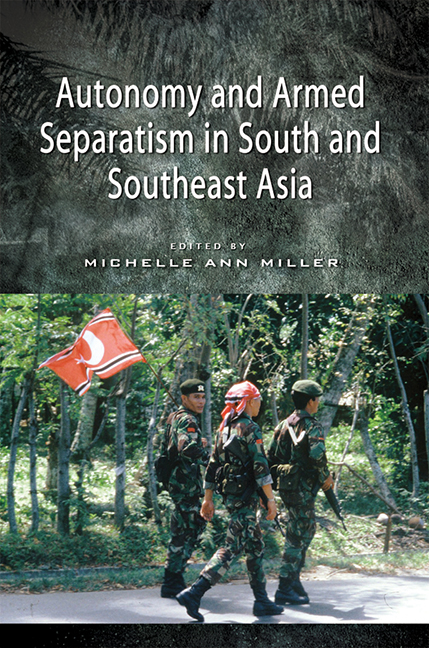Book contents
- Frontmatter
- Dedication
- Contents
- Acknowledgements
- About the Contributors
- 1 The Problem of Armed Separatism: Is Autonomy the Answer?
- 2 Mediated Constitutionality as a Solution to Separatism
- 3 Self-Governance as a Framework for Conflict Resolution in Aceh
- 4 Autonomy and Armed Separatism in Papua: Why the Cendrawasih Continues to Fear the Garuda
- 5 The Parallels and the Paradox of Timor-Leste and Western Sahara
- 6 Between Violence and Negotiation: Rethinking the Indonesian Occupation and the East Timorese Resistance
- 7 Struggle over Space in Myanmar: Expanding State Territoriality after the Kachin Ceasefire
- 8 Sri Lanka's Ethnic Conflict: The Autonomy-Separation Dialectic
- 9 Unitarianism, Separatism and Federalism: Competing Goals and Problems of Compromise in Sri Lanka
- 10 Autonomy and Armed Separatism in Jammu and Kashmir
- 11 Armed Conflicts and Movements for Autonomy in India's Northeast
- 12 Southern Thailand: The Trouble with Autonomy
- 13 The Last Holdout of an Integrated State: A Century of Resistance to State Penetration in Southern Thailand
- 14 Interlocking Autonomy: Manila and Muslim Mindanao
- 15 History, Demography and Factionalism: Obstacles to Conflict Resolution through Autonomy in the Southern Philippines
- 16 Conclusion
- Index
7 - Struggle over Space in Myanmar: Expanding State Territoriality after the Kachin Ceasefire
Published online by Cambridge University Press: 21 October 2015
- Frontmatter
- Dedication
- Contents
- Acknowledgements
- About the Contributors
- 1 The Problem of Armed Separatism: Is Autonomy the Answer?
- 2 Mediated Constitutionality as a Solution to Separatism
- 3 Self-Governance as a Framework for Conflict Resolution in Aceh
- 4 Autonomy and Armed Separatism in Papua: Why the Cendrawasih Continues to Fear the Garuda
- 5 The Parallels and the Paradox of Timor-Leste and Western Sahara
- 6 Between Violence and Negotiation: Rethinking the Indonesian Occupation and the East Timorese Resistance
- 7 Struggle over Space in Myanmar: Expanding State Territoriality after the Kachin Ceasefire
- 8 Sri Lanka's Ethnic Conflict: The Autonomy-Separation Dialectic
- 9 Unitarianism, Separatism and Federalism: Competing Goals and Problems of Compromise in Sri Lanka
- 10 Autonomy and Armed Separatism in Jammu and Kashmir
- 11 Armed Conflicts and Movements for Autonomy in India's Northeast
- 12 Southern Thailand: The Trouble with Autonomy
- 13 The Last Holdout of an Integrated State: A Century of Resistance to State Penetration in Southern Thailand
- 14 Interlocking Autonomy: Manila and Muslim Mindanao
- 15 History, Demography and Factionalism: Obstacles to Conflict Resolution through Autonomy in the Southern Philippines
- 16 Conclusion
- Index
Summary
In the context of the Union of Myanmar/Burma, the application of several concepts that are suggestive of autonomy for ethnic minority regions can be misleading for the wider international community. In Myanmar, “union” reads as “unitary”, illegitimate can be treated as “legal”, and “legal” may actually mean “illegitimate”. In a similar vein, the term “ceasefire” as a stage in ethnic minority conflict resolution — as read by the international community — may have very different implications when it involves unilateral offers made by Myanmar's ruling military authorities to armed ethnic groups. For practical purposes, such “ceasefires” are simply aimed at enforcing authoritarian order while indefinitely staving off ethnic minority demands for greater political autonomy within their historic homelands.
The central argument in this chapter is that the establishment of ceasefires has made the task of achieving territorial control largely easier for the Tatmadaw. It has also helped to bolster the military's ambitions of legitimizing its state-building efforts while depriving minority groups of any meaningful autonomy. To this end, the chapter will discuss the military's version of state-building in relation to the autonomy expectations of the Kachin ethnic minority. After a brief overview of the evolvement of the Kachin armed resistance (1961–94), it will then focus on the trends and developments during the 1994–2011 ceasefire in Kachin State.
BACKGROUND
Myanmar is variously viewed as an authoritarian “ethnocratic” state (Brown 1994) or an “illiberal” and uncertain “unitary state” (Tin 2004). The malfunctioning of many of the institutions expected from a state (in the Westphalian sense) such as law enforcement agencies, ministries and executive branches, has prompted designations of “weak” or “failed” for Myanmar as a state, although never “un-sovereign”. “… Myanmar is a juridical state rather than an empirical one. Or … it is a “weak” state because ‘the institutions of the state are contested to the point of violence’” (Rajah 2001, p. 14 quoting Buzan).
- Type
- Chapter
- Information
- Autonomy and Armed Separatism in South and Southeast Asia , pp. 113 - 135Publisher: ISEAS–Yusof Ishak InstitutePrint publication year: 2012



